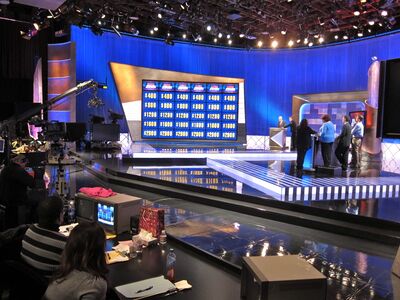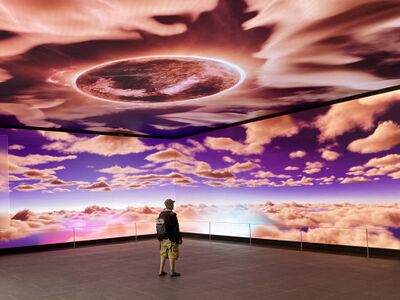Difference between revisions of "A Light-emitting World"
(Created page with "''By the end of the 2010s, LED lighting was on the brink of taking over as the light source for stage lighting. This shift was controversial for some lighting professionals, b...") |
|||
| Line 1: | Line 1: | ||
| − | ''By the end of the 2010s, LED lighting was on the brink of taking over as the light source for stage lighting. This shift was controversial for some lighting professionals, but now we have LEDs almost everywhere.'' | + | ''By the end of the 2010s, LED lighting was on the brink of taking over as the light source for stage lighting. This shift was controversial for some lighting professionals, but now we have LEDs almost everywhere.'' |
| + | [[File:IO2 C.10 7.jpg|400px|thumb|left|LEDs in the set of the game show Jeopardy!]] | ||
| + | |||
From its introduction in the late 19th century, the [[Item:Q3120|incandescent lamp]] (Q3120) became the dominant light source not only in theatres, but in almost all situations where artificial light was needed. In many ways it was ideal – the warm colour was flattering to actor’s skin tones, the full spectrum ensured the colours of scenery and costumes were seen correctly, and the lamps could easily be dimmed smoothly to zero. However, it had disadvantages: a relatively short life, and low efficiency, with most of the power consumed being converted to heat, not light. Alternatives were developed, which found applications outside theatre, but both [[Item:Q30636|fluorescent tubes]] (Q30636) and the various types of [[Item:Q3093|discharge lamp]] (Q3093) had the same problems for stage lighting: they had poor rendering of colours and could not be dimmed smoothly to black. They found some limited applications in theatres, with fluorescent lamps being used, combined with special dimming systems, for lighting cycloramas where their linear, smooth light distribution was ideal. Discharge lamps were used for high power applications, and later for moving lights, combined with mechanical dimming systems. | From its introduction in the late 19th century, the [[Item:Q3120|incandescent lamp]] (Q3120) became the dominant light source not only in theatres, but in almost all situations where artificial light was needed. In many ways it was ideal – the warm colour was flattering to actor’s skin tones, the full spectrum ensured the colours of scenery and costumes were seen correctly, and the lamps could easily be dimmed smoothly to zero. However, it had disadvantages: a relatively short life, and low efficiency, with most of the power consumed being converted to heat, not light. Alternatives were developed, which found applications outside theatre, but both [[Item:Q30636|fluorescent tubes]] (Q30636) and the various types of [[Item:Q3093|discharge lamp]] (Q3093) had the same problems for stage lighting: they had poor rendering of colours and could not be dimmed smoothly to black. They found some limited applications in theatres, with fluorescent lamps being used, combined with special dimming systems, for lighting cycloramas where their linear, smooth light distribution was ideal. Discharge lamps were used for high power applications, and later for moving lights, combined with mechanical dimming systems. | ||
[[Item:Q3195|Light-emitting diodes]] (LEDs, Q3195) are electronic devices that produce light by electroluminescence when an electric current is passed through them. The first commercial LEDs appeared in 1968, but they were inefficient and could only emit a deep red colour, restricting their use to numeric displays and indicator lights. Further development over the following years produced yellow, green and eventually blue LEDs, as well as an exponential rise in brightness and reduction in cost – a phenomenon known as Haitz’s Law. | [[Item:Q3195|Light-emitting diodes]] (LEDs, Q3195) are electronic devices that produce light by electroluminescence when an electric current is passed through them. The first commercial LEDs appeared in 1968, but they were inefficient and could only emit a deep red colour, restricting their use to numeric displays and indicator lights. Further development over the following years produced yellow, green and eventually blue LEDs, as well as an exponential rise in brightness and reduction in cost – a phenomenon known as Haitz’s Law. | ||
| + | |||
| + | [[File:IO2 C.10 5.jpg|400px|thumb|right|LED walls and ceiling at Outernet, an immersive entrtainment venue in London.]] | ||
With the development of high-efficiency and high-power LEDs, it became possible to use them in lighting applications. In 1997 the very first LED stage lights were presented at the LDI trade show in Las Vegas. They used red, green and blue LEDs that could be controlled separately, allowing a wide variety of colours to be produced. However, the three colours when mixed did not produce a clean white, and colour rendering was poor. For producing an impact with strong colours, the early LED spotlights were effective, but the quality of white light for theatre use on performers was inadequate. By the mid 2010s the first white LED were being produced, employing a phosphor coating to partially convert the emitted blue light to red and green frequencies, creating a light that appeared white. It seemed at that point that LEDs were the future of lighting, with the benefits of greater efficiency, long life and compact size. LEDs could also be used to produce light sources with variable colour, the new white LEDs ensuring that a good quality white light could be included in the range of mixable colours. | With the development of high-efficiency and high-power LEDs, it became possible to use them in lighting applications. In 1997 the very first LED stage lights were presented at the LDI trade show in Las Vegas. They used red, green and blue LEDs that could be controlled separately, allowing a wide variety of colours to be produced. However, the three colours when mixed did not produce a clean white, and colour rendering was poor. For producing an impact with strong colours, the early LED spotlights were effective, but the quality of white light for theatre use on performers was inadequate. By the mid 2010s the first white LED were being produced, employing a phosphor coating to partially convert the emitted blue light to red and green frequencies, creating a light that appeared white. It seemed at that point that LEDs were the future of lighting, with the benefits of greater efficiency, long life and compact size. LEDs could also be used to produce light sources with variable colour, the new white LEDs ensuring that a good quality white light could be included in the range of mixable colours. | ||
Latest revision as of 19:41, 18 February 2023
By the end of the 2010s, LED lighting was on the brink of taking over as the light source for stage lighting. This shift was controversial for some lighting professionals, but now we have LEDs almost everywhere.
From its introduction in the late 19th century, the incandescent lamp (Q3120) became the dominant light source not only in theatres, but in almost all situations where artificial light was needed. In many ways it was ideal – the warm colour was flattering to actor’s skin tones, the full spectrum ensured the colours of scenery and costumes were seen correctly, and the lamps could easily be dimmed smoothly to zero. However, it had disadvantages: a relatively short life, and low efficiency, with most of the power consumed being converted to heat, not light. Alternatives were developed, which found applications outside theatre, but both fluorescent tubes (Q30636) and the various types of discharge lamp (Q3093) had the same problems for stage lighting: they had poor rendering of colours and could not be dimmed smoothly to black. They found some limited applications in theatres, with fluorescent lamps being used, combined with special dimming systems, for lighting cycloramas where their linear, smooth light distribution was ideal. Discharge lamps were used for high power applications, and later for moving lights, combined with mechanical dimming systems.
Light-emitting diodes (LEDs, Q3195) are electronic devices that produce light by electroluminescence when an electric current is passed through them. The first commercial LEDs appeared in 1968, but they were inefficient and could only emit a deep red colour, restricting their use to numeric displays and indicator lights. Further development over the following years produced yellow, green and eventually blue LEDs, as well as an exponential rise in brightness and reduction in cost – a phenomenon known as Haitz’s Law.
With the development of high-efficiency and high-power LEDs, it became possible to use them in lighting applications. In 1997 the very first LED stage lights were presented at the LDI trade show in Las Vegas. They used red, green and blue LEDs that could be controlled separately, allowing a wide variety of colours to be produced. However, the three colours when mixed did not produce a clean white, and colour rendering was poor. For producing an impact with strong colours, the early LED spotlights were effective, but the quality of white light for theatre use on performers was inadequate. By the mid 2010s the first white LED were being produced, employing a phosphor coating to partially convert the emitted blue light to red and green frequencies, creating a light that appeared white. It seemed at that point that LEDs were the future of lighting, with the benefits of greater efficiency, long life and compact size. LEDs could also be used to produce light sources with variable colour, the new white LEDs ensuring that a good quality white light could be included in the range of mixable colours.
However, in 2018 the European Union announced proposals to ban the sale of tungsten lamps, as part of its measures to address the climate emergency. Lighting designers in the live event and architectural fields were concerned that the available LED lights could not meet their requirements, in particular the quality of white light on skin tones, and launched a ‘Save Tungsten’ campaign. Industry representatives met with the EU to argue the case, pointing out that not only could tungsten incandescent lamps not meet the efficiency requirements in the proposed regulations, neither could the new LED stage lights – their colour mixing and optical systems required for stage use reducing the overall efficiency below that required. They were able to negotiate some adjustments to the regulations, with exemptions for the main types of lamp used by the entertainment lighting industry.
Technology advances, and most of the disadvantages of LED have been addressed by manufacturers, though it has taken several years to win over the most sceptical lighting professionals. Manufacturers have developed colour mixing systems using up to seven different colours, to ensure accurate, high-quality colour rendering, especially the subtle near-white tones that are required for lighting people on stage and on camera. Experiments suggest that even experienced professional lighting designers can no longer tell a high-quality LED source from a tungsten one, in a blind test.
While the introduction of LEDs to main stage lighting has been controversial, LEDs have quietly taken over another important role on stages and television studios. The features that made LEDs a useful light source in their early days – compact size, low heat output, and a range of colours – meant they are now the main solution whenever a light source needs to be embedded in the set. Strips and panels of LEDs create graphic, radiant lines that mark out the edges of scenery, or create architectures of pure light in space. Not only are the overhead lighting positions full of LED sources, now almost any surface, any scenic element, can glow and colour-shift with rippling, strobing illuminations: LEDs everywhere.

